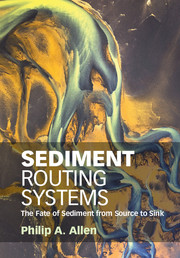Book contents
- Frontmatter
- Contents
- Preface
- Part I A Global View of Sediment Routing Systems
- Part II The Segments of Sediment Routing Systems
- Part III The Functioning of Sediment Routing Systems
- 7 Denudation and Sedimentation
- 8 Dynamics of Sediment Routing Systems
- Part IV The Stratigraphic Record of Sediment Routing Systems
- References
- Index
8 - Dynamics of Sediment Routing Systems
from Part III - The Functioning of Sediment Routing Systems
Published online by Cambridge University Press: 03 October 2017
- Frontmatter
- Contents
- Preface
- Part I A Global View of Sediment Routing Systems
- Part II The Segments of Sediment Routing Systems
- Part III The Functioning of Sediment Routing Systems
- 7 Denudation and Sedimentation
- 8 Dynamics of Sediment Routing Systems
- Part IV The Stratigraphic Record of Sediment Routing Systems
- References
- Index
Summary
Moving Boundaries
The segments of sediment routing systems are characterised by a particular set of physical processes and depositional environments (Sømme et al., 2009; Carvajal and Steel, 2012). Segments are commonly separated from other segments by boundaries or transition zones involving complex processes of energy and sediment transfer, which are examples of ‘moving boundaries’ (Swenson et al., 2000, 2005; Kim et al., 2006). The equivalent concept in sequence stratigraphy is the analysis of the shoreline or shelf edge trajectory (Helland- Hansen and Hampson, 2009) (Chapter 10). The position of moving boundaries is a sensitive indicator of the functioning of the sediment routing system. They are commonly filters or barriers to the propagation of sediment flux signals from upland catchments. There are therefore ‘teleconnections’ between different parts of the sediment routing system, which enable signals originating in one segment to be transferred to a different, adjoining segment (Hoth, Kukowski, and Oncken, 2008).
Moving boundaries such as the coast-shoreface and shelf edge migrate in response to external forcings and internal dynamics. Migration results in characteristic stratigraphic architectures, especially patterns of progradation or flooding of the clinoforms that are conspicuous in seismic reflection profiles. Clinoforms representing the shelf edge and smaller clinoforms representing the shoreface migrate independently and sometimes out of phase with each other, principally under the effects of sediment dynamics set up by river floods, wave energy and storm-driven currents (Swenson et al., 2005) (Section 5.3, Figure 5.10). If one clinoform set can grow while another of the same age shrinks, then oceanographic effects may clearly dominate over eustatic change in generating stratigraphic architectures.
The Gravel Front and Gravel Cline
It is well known that gravel-sand rivers exhibit an abrupt grain-size transition, termed the ‘gravel front’ or the ‘gravel-sand transition’ (Dubille and Lavé, 2015), generally accompanied by a rapid change of slope (Smith and Ferguson, 1995; Cui and Parker, 1998; Parker and Cui, 1998; Knighton, 1999; Ferguson, 2010). The gravel front is a moving boundary that changes in its downstream position in response to changes in boundary conditions (Paola, 2000; Marr et al., 2000) or as a result of the unperturbed evolution of a drainage network (Gasparini, Tucker, and Bras, 1999). In present-day rivers, the gravel front coincides with a gap (at a median size of 1−10 mm) in the grain size of sediment comprising the river bed.
- Type
- Chapter
- Information
- Sediment Routing SystemsThe Fate of Sediment from Source to Sink, pp. 240 - 294Publisher: Cambridge University PressPrint publication year: 2017



